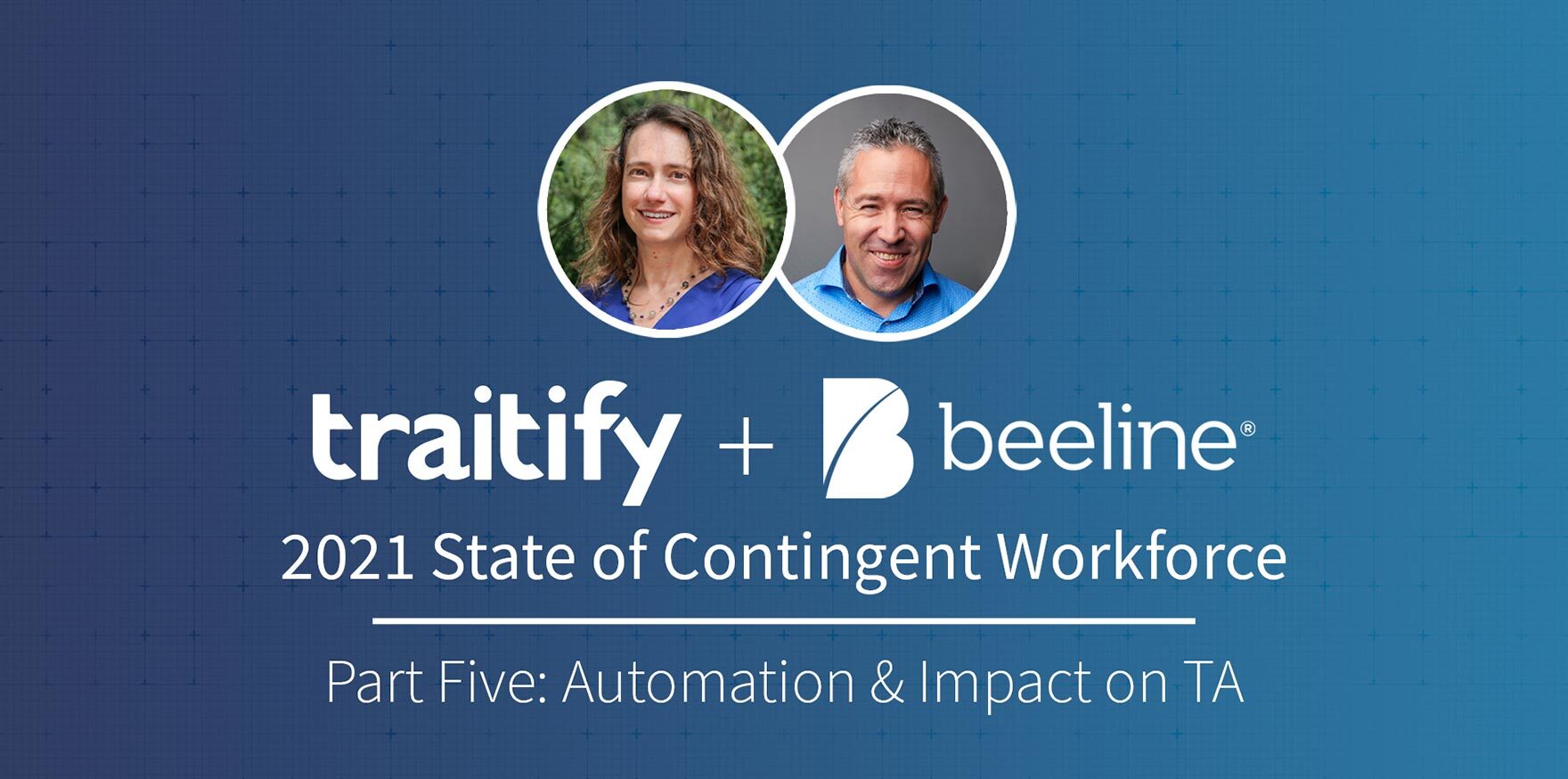To conclude our five-part video series, Dr. Heather Myers of Traitify and Brian Hoffmeyer of Beeline examine how recruitment automation can help humans and machines work better together and how the extended workforce impacts talent acquisition and procurement.
ICYMI, here is the 4th part of the series on making vaccines, DEI, and other ways this sector was impacted by COVID-19 — and vice versa.
Need to start from the beginning? Meet our experts in part 1.
The full series is also on YouTube here.
Transcript:
HEATHER: Kind of switching gears a little bit, what do you see in terms of the role for recruitment automation, and sort of other innovations in this kind of post-COVID, pandemic contingent landscape?
BRIAN: I think there's a huge, huge opportunity for automation, you know? My belief is to let computers, broadly, do things that humans shouldn't have to do, right? Do repetitive tasks. Help make better decisions. But again, to the point earlier of like—you know—you can probably very easily automate the procurement of Sharpies.
HEATHER: Right.
BRIAN: You can't fully automate—you can't take the people out of the recruitment process — and that applies to all types of workers. But what you can do with all these tools is you can make them better. You can get rid of mundane, repetitive tasks. You can assist with better decision making through artificial intelligence. All of those kinds of things. So I think that's just a huge role, and one we’ll see continue to evolve. And, I mean, there is some—you know—there are even some elements of recruitment that can be automated, as well: the repetitive aspects. And that let’s recruiters be more effective, because they can then focus on the things that only people can do.
HEATHER: Do you have any stories around that? Like, is there anything that you've seen that's really, kind of brought to light the way this can be used to make this functionality better?
BRIAN: Yeah, I mean I think we’re seeing—I'll give you an example of something we've done, right? We've got a chatbot built within Beeline that automates the process of extending someone's assignment. So it’s a very common in our world—you know—someone's engage for three months but the project isn't done for—isn’t done at the end of three months, and you need to send them—
HEATHER: Sure.
BRIAN: —a contract for another two, or what have you, right? So a very repetitive task that can be automated. And again, then the manager who is responsible for that person can concentrate on doing something that truly adds value, right? Managing that person whose assignment is being expended better. Working on other projects. And so, that’s just one small example. Again, everything we’re focused on is helping humans and machines work better together. And again, you know, I think everything you guys are doing helps with that. A really simple, quick test—like I really nerd out about what Traitify does, as you know—and it helps make decisions better and faster.
HEATHER: Right. So how do you see, more broadly, the contingent workforce (or the extended workforce) impacting the way talent acquisition and procurement works in 2021? Because, as you’ve said, clearly there needs to be an interplay. So, do you—how do you envision that looking?
BRIAN: Yeah, I mean I think it's—first and foremost the number one thing is that those stakeholders have to tie their goals around the contingent workforce to corporate goals, right? They have to say, “We’re using non-employees, because we have a need to grow 10% this year, and we don't have the employees to do it,” or “We have this special project we're trying to do, this massive initiative within our organization.” So that's just the number one thing, like the number one piece of advice. Like clients will often come to us and say, “We need cost-savings. We want we want to drive”— because contingent workforce is generally the second biggest cost at most companies, after employee salaries—
HEATHER: Oh, interesting. Sure.
BRIAN: —so people are looking for savings. But like, why? Why are you looking for savings? And what is the trade off of that savings, right? If you—
HEATHER: Right.
BRIAN: Like with people, and with all things, in some ways you get what you paid for. So if you drive down the cost, but your project takes two months longer to complete, you haven’t achieved anything.
HEATHER: Right.
BRIAN: Or maybe you’ve achieved something, but it isn’t what you’re trying to achieve. So I think that’s just the number one thing that procurement and talent acquisition has to do. And that will then let them start to make those decisions about: what is the right mix of workers?
HEATHER: Right.
BRIAN: And ultimately, when a manager needs to get work done, what is the best way for that work to get done at that particular time? And so like, that’s very much an area of focus.
HEATHER: Yeah. I mean that makes a lot of sense, because its perceived value—or perceived savings is not actually—necessarily doesn’t translate to actual savings sometimes.
BRIAN: No. Definitely not.
HEATHER: And so I think that’s, you know, a very important thing to kind of figure out.
Contact:
Heather Myers, Ph.D. - heather@traitify.com, Heather Myers, Ph.D.
Brian Hoffmeyer - hoff@beeline.com, Brian Hoffmeyer, homechefhoff
To learn how Traitify can help you attract, select, and engage contingent workers, connect with us!





